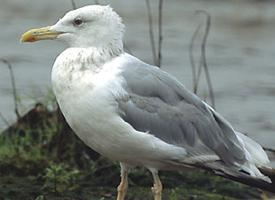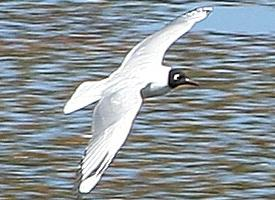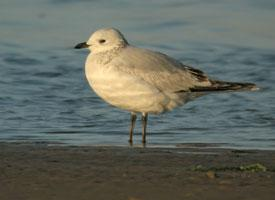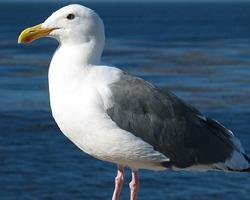
Stav ohrožení
| Ohrožen |
Popis zvířete
The Caspian Gull, scientifically known as Larus cachinnans, is a large species of gull that is primarily found in the Palearctic region, stretching across Europe, the Middle East, and Central Asia. This species is closely related to the Herring Gull and Yellow-legged Gull, and it was once considered a subspecies of the Herring Gull. However, it is now recognized as a distinct species due to its unique morphological and genetic characteristics.Physical Description:
The Caspian Gull exhibits a slender and elegant profile, with a body length ranging from 56 to 68 cm and a wingspan of about 140 to 155 cm. Adults display a pale grey back and upper wings, which contrast sharply with their white underparts. The wings are long and pointed, featuring black wingtips with large white spots, known as mirrors. One of the distinguishing features of the Caspian Gull is its large, yellow bill with a distinct red spot on the lower mandible, which plays a crucial role in chick feeding behavior. Its legs are usually yellow, and its eyes are pale with a bright yellow iris, surrounded by a bare yellow or orange orbital ring.
Juveniles and immature birds go through a complex series of plumage changes over their first four years before acquiring the full adult plumage. Initially, they have a mottled brown and white appearance, gradually transitioning to the sleek grey and white of mature adults. These changes make the identification of younger birds challenging, even for experienced birdwatchers.
Habitat and Distribution:
Caspian Gulls are adaptable birds that can be found in a variety of habitats, ranging from lakes, rivers, and seashores to agricultural fields and urban areas. They are primarily migratory, breeding in parts of Eastern Europe and Western Asia, and wintering in the Mediterranean, Middle East, and the Indian subcontinent. Some populations are resident or partially migratory, depending on the local climate and food availability.
Behavior and Diet:
Caspian Gulls are opportunistic feeders with a varied diet that includes fish, insects, small mammals, and carrion. They are also known to scavenge at landfill sites and can display kleptoparasitic behavior, stealing food from other birds. These gulls are social birds, often found in mixed-species flocks, especially outside the breeding season. Their calls are loud and raucous, similar to those of other large gull species, and play an important role in communication within colonies.
Reproduction:
The breeding season begins in early spring, with Caspian Gulls forming monogamous pairs that return to the same nesting sites year after year. Nests are typically built on the ground, often on islands or isolated shores, to reduce predation risk. They are constructed from vegetation and sometimes include man-made materials. Females lay two to four eggs, which are incubated by both parents for about 25 to 30 days. The chicks are semi-precocial, hatching with their eyes open and covered in down, but rely on their parents for food and protection for several weeks before fledging.
Conservation Status:
Currently, the Caspian Gull is not considered to be at significant risk, and it is classified as Least Concern by the International Union for Conservation of Nature (IUCN). However, like many species, it faces threats from habitat destruction, pollution, and climate change. Conservation efforts focused on protecting natural habitats and monitoring population trends are essential to ensure the long-term survival of this species.
In summary, the Caspian Gull is a fascinating and adaptable bird, with distinctive features and behaviors that make it a subject of interest for birdwatchers and researchers alike. Its wide distribution and varied habitats highlight the ecological importance of this species within its range.
Podobná zvířata
Nové fotografie zvířat
Top 10 zvířat
- Chinese water dragon (Physignathus cocincinus)
- Galápagos tortoise (Geochelone nigra complex)
- Dolphin gull (Leucophaeus scoresbii)
- Japanese macaque (Macaca fuscata)
- Colombian red howler (Alouatta seniculus)
- Sea urchins (Echinoidea)
- Moustached guenon (Cercopithecus cephus)
- Diana monkey (Cercopithecus diana)
- Common reed warbler (Acrocephalus scirpaceus)
- Common house mosquito (Culex pipiens)


